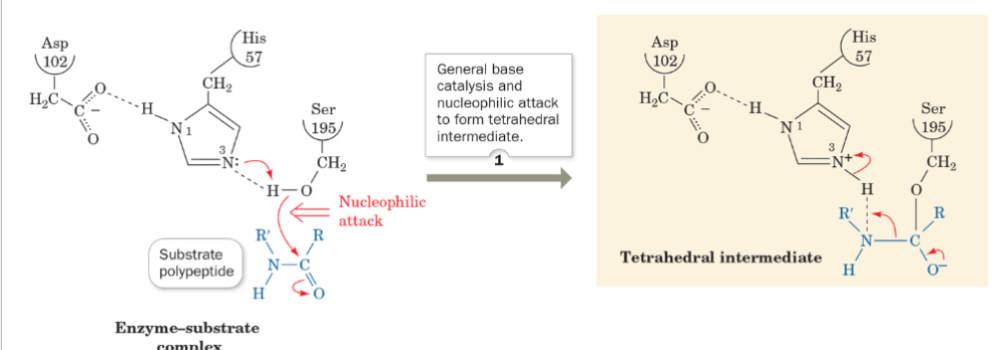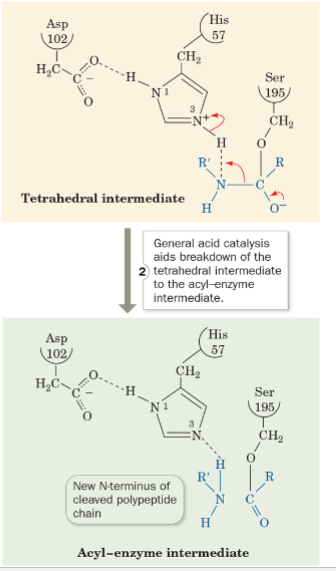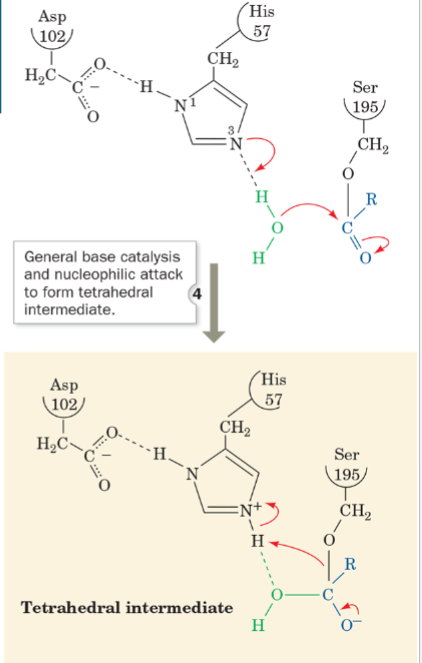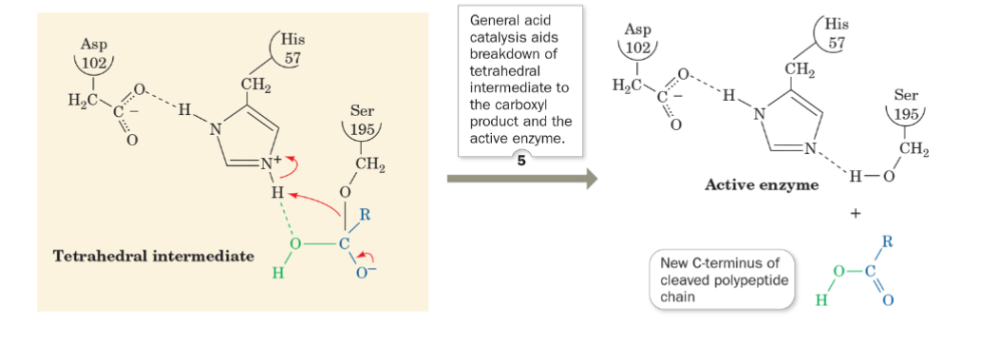Enzymes are catalyst and
speed up reactions and are constantly moving
Active site conformation changes can:
1. Assist substrate binding
2. Bring catalytic groups into position
3. Assist in bond making and bond breaking
4. Facilitate conversion of substrate to product
Enzymes differ from ordinary chemical catalysts in
reaction rate, reaction conditions, reaction specificity, and regulation
The unique physical and chemical properties of the_____limit an enzymes activity to specific substrates and reactions
active sites
Some enzymes require
metal ions or organic cofactors
Enzymes catalyze________reactions, causing them to proceed at extraordinarily rapid rates
thermodynamically favored
what word is used to describe rates
kinetic
The catalyzed and uncatalyzed rate:
catalyzed: 3.0x104sec^-1
uncatayzed: 3.0x10-10sec^-1
How to calculate the ratio for catalytic power?
3.0x104/3.0x10-10=1.0x1014
Any chemical reaction in which the oxidation numbers of the atoms are changed
oxidation-reduction(redox) reaction
What is the classification of an oxidation-reduction reaction?
oxidoreductases
What is the classification of a transfer of functional groups?
transferases
What is the classification of a hydrolysis reactions?
hydrolases
What is the classification of a group elimination to form double bonds?
lyases
What is the classification of isomerization?
isomerases
What is the classification of a bond formation coupled with ATP hydrolysis?
Ligases
The_______from one molecule (the donor) to another (the acceptor)
transfer of functional groups
A chemical compound by a reaction with water. Breaks down a variety of polymers, including proteins, carbs, fats, and nucleic acids
Hydrolysis
Catalyze the breaking of various chemical bonds by means other than hydrolysis and oxidation, often forming new double bonds
Lyases
Structural rearrangement of isomers (same molecular weight, but diff. structural formulas)
Isomerization
Reaction joining of two large molecules by forming a new chemical bond
Ligases
the selectivity of enzymes for their substrates
Enzyme specificity
Exquisite stereospecificity is observed
for some enzymes
what are cofactors?
are non-protein groups that are needed in active sites to carry out functions that amino acid side chains cannot
Functional groups of proteins facilitate
-acid-base reactions
- transient(short-lived)covalent bonds
-Charge-charge interactions
Cofactors have
metal ions and coenzymes
Coenzymes have
Cosubstrates and prosthetic groups
Transiently associates with enzymes so that it functions as a substrate
cosubstrates
permanently(often covalently) attached to enzymes
Prosthetic groups
________are catalytically active enzymes with its cofactor complex
Holoenzymes
______enzyme without the cofactor
Apoenzyme
_______must be regenerated for completion of a "catalytic cycle"
Coenzymes
What are the five principles of regulated enzyme activity?
1. Allosteric control
2. Multiple forms of enzymes
3. Reversible covalent modification
4. Proteolytic activation
5. Controlling the amount of enzyme present
Are inactive precursors of enzymes
zymogens
Proteolytic cleavage produces the active enzyme
chymotrypsinogen---->chymotrypsin
are non-protein components essential to enzyme activity
Enzyme cofactors and coenzymes
An enzyme provides a lower-energy pathway from substrate to product but
does not affect the overall free energy change for the reaction
The active sites of enzymes bind the transition state of the reaction more tightly than they____
bind to the substrate
The transition state sits at the _____ of the energy profile in the energy diagram
apex
the reaction rate is proportional to the
concentration of reactant molecules that reached the transition-state energy
The higher the delta G^+-,
the slower the reaction
Decreasing delta G^+-,
increase the reaction rate (speeds up the reaction)
The catalytic role of an enzyme is to reduce the energy barrier between
substrate s and transition state X^+-
Rate acceleration by an enzyme means that the energy barrier between
ES and EX^+- must be smaller than the barrier between S & X^+-
The enzyme must stabilize the EX^+- transition state
more than it stabilizes ES
Binding cannot be too tight because the goal is to make
the energy barrier between ES EX^+- small
RAising the starting energy of ES to a more positive delta G,
will increase the catalyzed rate
The ES complex is a more highly ordered
for low-entropy state for the substrate
Amino-acid side chains that can donate or accept protons can participate in chemical reactions as acid and base catalysts
Acid/base catalysis
Groups can catalyze reactions through the transient formation of covalent bonds with the substrate
Nucleophilic attack
The unique electronic properties of a metal ion facilitate the reaction
Metal ion catalysis
Enzymes accelerate reaction by bringing reacting group together and orienting them for reaction
Proximity and Orientation
Significantly lowers the activation energy for a reaction
Transition state stabilization
A binding pocket determines the
substrate specificity of the various serine proteases
the catalytically active__________ residues of serine proteases were identified by chemical labeling and structural analysis
Ser, His, and Asp
what is step 1 of the mechanism of serine protease?

General base catalysis, nucleophilic attack to form tetrahedral intermediate
what is step 2 of the mechanism of serine protease?

General Acid Catalysis aids breakdown of
Tetrahedral Oxyanion
Intermediate, leaving the
Acyl Enzyme Intermediate on Ser 195
what is step 3 of the mechanism of serine protease?

Amine product is released and replaced by water
what is step 4 of the mechanism of serine protease?

General Base Catalysis, Nucleophilic
Attack to form Tetrahedral,
Oxyanion Intermediate
what is step 5 of the mechanism of serine protease?

General acid catalysis aids breakdown of tetrahedral intermediate to the carboxyl product and the active enzyme
Raising the energy of ES is accomplished by
A) loss of entropy
B) destabilization of ES complex by
-desolvation
-strain/distortion
Entropy loss is caused by the
formation of the ES complex. This complex is highly ordered, low-entropy state for a substrate
Desolvation is the result of
water loss which raises the energy of the ES complex
Destabilization is
provoking repulsion based on charges
Proximity and Orientation
Asp 102 functions only to orient His57
Acid/base catalysis
His57 acts as general acid and base
Nucleophilic attack
Ser195 formas a transient covalent bond with peptide to be cleaved
trigonal to tetrahedral
transition state-stabilization
tetrahedral oxyanion intermediate is stabilized by the backbone N-H of Gly193 and Ser195 the Oxyanion Hole
Segments of RNA that display enzyme activity
riboenzymes